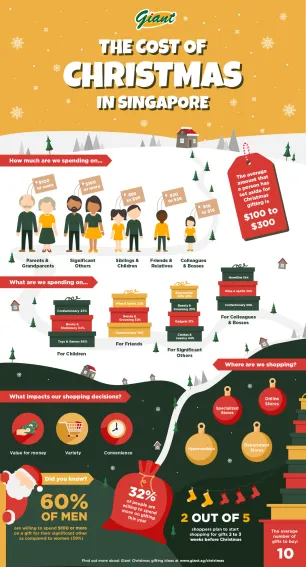
Christmas shopping habits revealed
Ever wondered how much Singaporeans spend on Christmas gifts for families, friends and colleagues? A recent survey commissioned by hypermarket chain Giant Singapore revealed insights on how much a shopper spends, where they spend it, who they spend it on and on what kind of Christmas gifts.
The survey, which polled 500 Singaporeans between the ages of 20 and 60 years old, discovered that this Christmas’ top gift recipients are children (53%) and close friends (49%), followed by significant others (43%) and colleagues/bosses (40%).
It seems that professional relationships sometimes trump personal relations, as close to 10% more respondents are likely to buy gifts for their colleagues and bosses as compared to shopping for their siblings or even parents. Whom they are buying Christmas gifts for also has a huge impact on their Christmas spending. The survey found that Singaporeans would spend S$100 (US$74) or more on each gift for parents, grandparents and significant others, while only spending S$50 - $99 on siblings and children, S$20 - $39 on close friends and relatives and only S$10 - $19 on colleagues and bosses.
Value for money, wide variety and convenience are the three most important consideration factors for Singaporeans when planning on where to shop for gifts. The survey found that Singaporeans are most likely to visit department stores and online stores followed by specialised shops and hypermarkets.
“Christmas gifting can be a very stressful process. It’s easy to get caught up in the quest for the perfect gift to cover everyone on your list. Although Singaporeans are taking a more generous approach to gifting this Christmas, they are still looking at ways to best stretch their festive dollar with affordability being a very important factor for gift ideas,” said Lim Wee Ling, marketing director at Giant Singapore.
Overall, the survey showed finding a meaningful gift is the most important factor for people when shopping. It’s especially true when the gift receivers are their significant others, parents, and grandparents. Affordability is the second most important factor, particularly when it comes to buying gifts for children, colleagues, and close friends, while practicality of the gift comes in third.
Men are the more generous spenders this holiday season with over 60% of them planning to spend $100 or more on gifts for their significant other as compared to women (39%). In fact, almost half of male respondents have set aside $300 and more on Christmas gifts, while only 32% of women plan to do the same.



















 Advertise
Advertise


